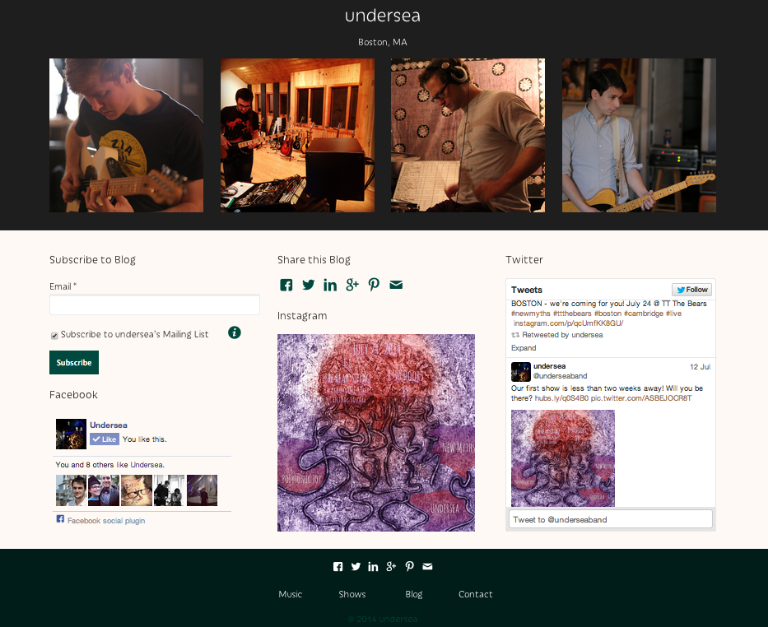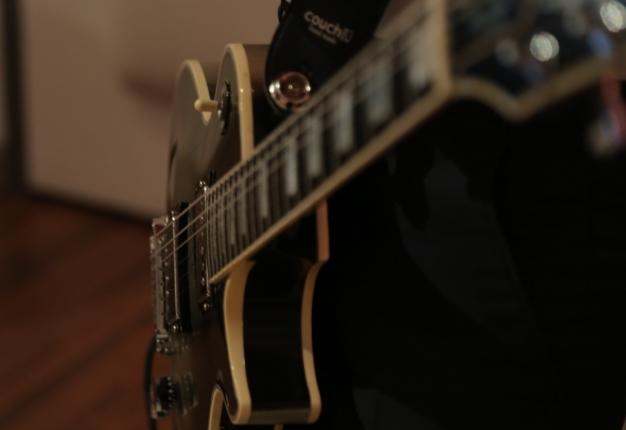If you are serious musician or in a band, then you probably have a Bandcamp, a Facebook page, a Soundcloud, and maybe a Twitter or Instagram account. While those platforms are all well and good, at the end of they day they aren't enough. Your band needs a website.
Bandcamp is a solid platform for selling music digitally online, but you are limited in terms of how your content is presented, and it's hard to stand out against the millions of other Bandcamp pages begging users to take their free music. Facebook pages are a great way to interact with fans, but there plenty of people who don't use Facebook and the vast majority of those who do spend a lot more time looking at BuzzFeed quizzes than they do band pages. You need a central hub, where you can tie all this disparate tools together; therefore, you need a website.
The major blockers for most bands to getting a website is that websites are generally complicated, cost money, and take time to maintain. The good news is there are some affordable and relatively easy options to getting a basic site up and running. But even when bands get a site up and running, I find they rarely update it, post to it, or touch it at all, so it quickly becomes out of date. The success of your online presence relies heavily on your ability to constantly put out content, not just when you have a new song or show.

Below are step by step instructions to setting up a simple website for your band.
1. Gather your content.
Any website is only as good as its content. Before you embark on building out a website, you want to make sure you have gathered the following assets:
- Music - you probably already have your music uploaded to Bandcamp, Soundcloud, and/or Reverb Nation. You can customize and copy the player embed code for, making it easy to load your music on your website.
- Photos - band promo pics, album art, live photos, show flyers etc. If you don't have any, have your photographer friend take some.
- Video - upload videos to services like YouTube or Vimeo. These services not only offer embed codes to load the videos into your pages, but also provide another channel for users to discover/interact with your music.
- Social Media embeds - If you are using Twitter, Instagram, Facebook, or other social media sites, you should include social embeds throughout your site to allow users to like or follow you via those platforms. You can easily create a Facebook Like Box, a Twitter feed widget, or an Instagram photo embed to add to your website.
- News, shows, posts, and update information - You'll want to have all the text about band updates, upcoming shows, etc. that you want to use on your site as well.
- Contact info - Make sure you have an easy way for users to get in touch with you. You will probably want a contact form on your site, but you may also consider setting up a band specific email address using a Gmail account or a custom domain name using Google apps ($5/month per email address)
2. Register a domain
Even if you don't have a website, you should always own a domain. At bear minimum, you can redirect the domain to your band's Facebook page or Bandcamp. It is impreative that you a simple domain that you can talk about with fans or other curious individuals.
You can register a domain with a number of services such as GoDaddy, eNom, Namecheap, and Bluehost. If you end up using Squarespace as your CMS, you get a free domain name as well (more on this below). All of these example registars provide search bars to check the availability of the domain you want. Try to get the simplest .com domain name that you can. If your band's name is already taken, try appending music or band to the end of the domain. You can also register phrases like weareinsertyourbandnamehere.com. It should be easy to remember.
Domain registration generally costs $5-14 dollars per year per domain (but can be more if you buy a covetted or a domain on auction), and you can skip the addons that these registrars will try to sell you. When you register a domain, you own the rights to that name on the Internet and you pay the registrar to manage and admisnister thoses rights. You may also considering registering multiple domains and redirecting these "vanity domains" to your primary domain. For example, www.underseamusic.com redirects to www.underseaband.com.
In addition to registering your domain, you will most likely need to pay for hosting, but this may be with a different company (see next step).
3. Choose a host and CMS
As previously mentionned, in addition to registering a domain, you will probably need to pay for hosting. With a hosting plan you are
The most important feature of your website is that you need to be able to edit and update the content. Frequent updates are key to generating traffic from search and social media channels, as well as other blogs and other sites. You could pay a designer to build you a slick looking website, but if you can't manage it, it is totally useless.
Therefore, your site needs to be built on a CMS or Content Management System. A CMS is software installed on your hosting server that allows you to edit and update your band website, without having to learn HTML/CSS/Javascript. Below are some recommendations that can help you decide which content managemnet system is right for your band:
Squarespace
If you aren't particularly technical and don't have access to designer, but still want a great looking website that is easy to update, Squarespace is probably the best option for you. This modern CMS is built specifically for creative professionals. You can get a basic account for $8 per month and this includes a free domain registration (see previous step). Squarespace has 24 out of the box templates that can be customized with your content. Squarespace also has help documentation and support to help you if you get stuck.

Wordpress
Wordpress.org is probably the most popular content management system on the Internet. This open-source platform proves ideal for bands who are a bit more technical and need a more custom sites. Wordpress has a thousands of free and paid themes, or you can hire a designer to build you a custom theme. While Wordpress is free, you will need to pay a company for hosting (ie GoDaddy, Blue Host, etc), which usually costs $4+ dollars per month. Most host companies offer a "1-click" install and support to help you get setup, but once you are up and running you may need to rely heavily on Wordpress's massive codex or theme specific help docs.
Wix
Wix is a free website builder that I've seen several bands use. While its not a bad option when you are first starting out, you may find yourself quickly outgrowing what Wix has to offer, because to get many of the more advanced features, you will have to upgrade your account.
HubSpot
If you have a label with a budget and a marketing team, you may want to consider a more advanced all in one marketing solution for your band (email, website, automation, social media tools, and contacts databse). HubSpot is a great option if you can afford it and have marketers with the time to manage.
4. Connect your domain to your content host
Once you have your domain registered and a CMS to host your content, you may need to connect the two. If you register your your domain and host your content with the same company, then you should be good to go. But if you register your domain with a separate company than your host, you will need to let the registrar know who your content host is. This process involves logging in to your registrar and updating the location of your nameservers or pointing indiviudal DNS records. While this may sound scary and technical, most content hosts and registrars have help docs and support teams that will help you take your site live. And if you want to avoid the complexity all together, register and host with the same company.
5. Login and begin building out your site
Log in to your CMS and begin building adding your content to your website. At bear minimum, you should try to create a home page, a contact us page, a shows page, and a blog/news page.
6. Going further
Once you have a basic site up, you can always improve upon it. Creating a website takes time, and if you don't have time for it, then it's worth investing in hiring someone to help you. If you do hire a designer, you want to make sure that whatever they build or set up for you, can be easily maintained by your group. And just like hiring an good recording engineer, you wnat to remember that you generally get what you pay for so the cheapest option isn't always the best. It is also important that you have a clear contract with the designer that specifies the scope of their work and their deliverables.



